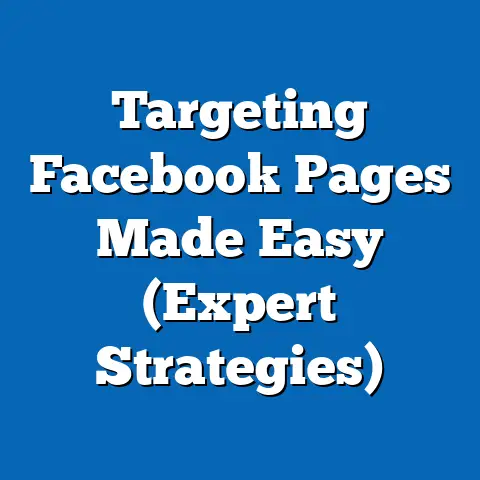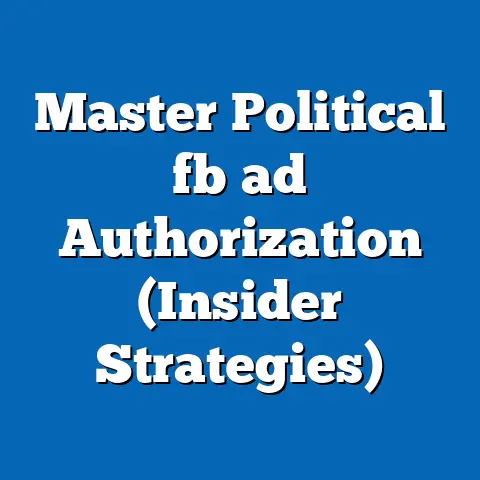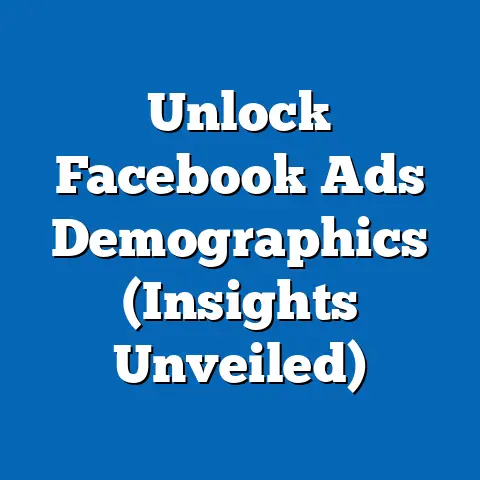Maximize Conversions: Change fb ad Goals to Purchase (Expert Tips)
Have you ever felt like you’re throwing money into a black hole with your Facebook ads? I get it. I’ve been there. You spend hours crafting the perfect ad, targeting the right audience, and setting a budget, only to see clicks that don’t translate into actual sales. It’s frustrating, and frankly, can be a massive drain on your business. I remember one client, a local bakery, who was getting tons of engagement on their ads but barely any new customers. They were essentially paying for likes and comments, not orders. This is a common problem, and it often stems from a fundamental misunderstanding of Facebook ad objectives.
The good news is, there’s a solution. It involves shifting your focus from general engagements like clicks or impressions to the ultimate goal: purchases. By changing your Facebook ad goals to prioritize conversions, you can significantly enhance the effectiveness of your campaigns and see a real return on your investment. In this guide, I’ll walk you through the steps and expert tips to make this transition, turning those clicks into customers and boosting your bottom line.
Understanding Facebook Ad Objectives
Before diving into the specifics of purchase goals, it’s crucial to understand the landscape of Facebook ad objectives. Facebook Ads Manager offers a range of options, broadly categorized into three sections: Awareness, Consideration, and Conversion. Each category serves a distinct purpose and impacts how Facebook delivers your ads and who it targets.
- Awareness: These objectives (Brand Awareness and Reach) are designed to increase visibility and introduce your brand to a wider audience. They’re ideal for new businesses or when launching a new product. Think of it as casting a wide net.
- Consideration: This category (Traffic, Engagement, App Installs, Video Views, Lead Generation, Messages) focuses on getting people to interact with your content and learn more about your business. It’s about sparking interest and building a connection.
- Conversion: This is where the magic happens. Objectives like Conversions, Catalog Sales, and Store Traffic are designed to drive specific actions, such as purchases, website visits, or store visits.
Many advertisers, especially those new to the platform, mistakenly choose objectives that don’t align with their ultimate goal of driving sales. They might opt for “Traffic” thinking that more website visitors will automatically lead to more sales. However, simply driving traffic doesn’t guarantee conversions. Facebook optimizes ad delivery based on the chosen objective. So, if you choose “Traffic,” Facebook will prioritize showing your ad to people who are most likely to click, not necessarily those who are most likely to buy. This is where I see so many businesses going wrong. They’re optimizing for the wrong outcome.
Key Takeaway: Align your ad objective with your business goals. If your goal is to drive sales, prioritize Conversion objectives like “Purchases.”
The Importance of Purchase Goals
The shift to purchase goals isn’t just a technical adjustment; it’s a strategic one that aligns with the psychology of consumer behavior. When you set your ad objective to “Purchases,” you’re telling Facebook that you want to target users who are most likely to complete a transaction. This focus leads to more targeted marketing efforts and a higher likelihood of converting potential customers.
I’ve seen firsthand the dramatic difference in conversion rates when businesses switch to purchase goals. I remember working with an e-commerce store that sold handmade jewelry. They were initially running ads with the “Traffic” objective and were frustrated with the lack of sales. After switching to the “Conversions” objective and optimizing their campaign for purchases, their conversion rate jumped by over 200% within a month!
Facebook’s algorithm plays a crucial role in this optimization. When you choose the “Purchases” objective, Facebook uses its vast data to identify users who have a history of making online purchases, are likely to add items to their cart, and are generally more inclined to convert. The algorithm learns from each conversion and refines its targeting over time, making your campaigns more effective as they run.
According to recent studies, businesses that optimize their Facebook ad campaigns for conversions see an average increase of 30% in sales compared to those that focus on broader objectives. This isn’t just about getting more clicks; it’s about getting the right clicks – the ones that lead to revenue.
Key Takeaway: Purchase goals allow Facebook’s algorithm to focus on users with a proven track record of making online purchases, leading to higher conversion rates.
Setting Up Your Campaign for Success
Now, let’s get into the nitty-gritty of setting up a Facebook ad campaign focused on purchase goals. Here’s a step-by-step guide:
- Create a New Campaign: In Facebook Ads Manager, click the “Create” button to start a new campaign.
- Choose the “Conversions” Objective: Select “Conversions” as your campaign objective. This signals to Facebook that your primary goal is to drive purchases.
- Name Your Campaign: Give your campaign a descriptive name that reflects its purpose (e.g., “Product X – Purchase Campaign”).
- Choose Your Conversion Event: This is where you tell Facebook what action you want to track as a conversion. Select “Purchase” from the dropdown menu. This requires you to have the Facebook Pixel installed on your website and properly configured to track purchase events.
-
Define Your Audience: This is critical. Don’t just target everyone and hope for the best. Think about your ideal customer. What are their demographics? What are their interests? What behaviors do they exhibit online? You can use Facebook’s targeting options to narrow your audience based on:
- Location: Target specific geographic areas.
- Demographics: Target based on age, gender, education, etc.
- Interests: Target users who have expressed interest in relevant topics.
- Behaviors: Target users based on their online behavior, such as purchase history or device usage.
- Custom Audiences: Upload a list of your existing customers (email addresses or phone numbers) to create a custom audience. This allows you to target your most loyal customers or create a lookalike audience (more on that below).
- Lookalike Audiences: Create an audience that is similar to your existing customers. Facebook will identify users who share similar characteristics and behaviors with your customer base. This is a powerful way to expand your reach and find new potential customers.
- Set Your Budget and Schedule: Determine how much you’re willing to spend on your campaign and how long you want it to run. You can choose a daily budget or a lifetime budget. It’s generally a good idea to start with a smaller budget and gradually increase it as you optimize your campaign.
- Choose Your Ad Placement: Decide where you want your ads to appear on Facebook and Instagram. You can choose automatic placements (where Facebook decides the best placements for you) or manual placements (where you select specific placements). I typically recommend starting with automatic placements and then refining your placements based on performance data.
Define Your Audience: This is critical. Don’t just target everyone and hope for the best. Think about your ideal customer. What are their demographics? What are their interests? What behaviors do they exhibit online? You can use Facebook’s targeting options to narrow your audience based on:
- Location: Target specific geographic areas.
- Demographics: Target based on age, gender, education, etc.
- Interests: Target users who have expressed interest in relevant topics.
- Behaviors: Target users based on their online behavior, such as purchase history or device usage.
- Custom Audiences: Upload a list of your existing customers (email addresses or phone numbers) to create a custom audience. This allows you to target your most loyal customers or create a lookalike audience (more on that below).
- Lookalike Audiences: Create an audience that is similar to your existing customers. Facebook will identify users who share similar characteristics and behaviors with your customer base. This is a powerful way to expand your reach and find new potential customers.
- Set Your Budget and Schedule: Determine how much you’re willing to spend on your campaign and how long you want it to run. You can choose a daily budget or a lifetime budget. It’s generally a good idea to start with a smaller budget and gradually increase it as you optimize your campaign.
- Choose Your Ad Placement: Decide where you want your ads to appear on Facebook and Instagram. You can choose automatic placements (where Facebook decides the best placements for you) or manual placements (where you select specific placements). I typically recommend starting with automatic placements and then refining your placements based on performance data.
Creating a compelling value proposition is also essential. Your ad copy and visuals should clearly communicate the benefits of your product or service and why people should buy from you. What problem does your product solve? What makes it unique? Why should someone choose your brand over the competition?
Key Takeaway: A well-defined audience, a clear conversion event, and a compelling value proposition are essential for a successful purchase-focused campaign.
Crafting Effective Ad Creatives
Your ad creatives (images and copy) are the first thing potential customers see, so they need to be attention-grabbing and persuasive. Here are some best practices for creating ad creatives that drive conversions:
- High-Quality Visuals: Use high-resolution images or videos that showcase your product in the best possible light. Avoid blurry or pixelated images. If you’re selling a product, show it in action. If you’re selling a service, use images that evoke the desired feeling or outcome.
- Clear Calls-to-Action (CTAs): Tell people exactly what you want them to do. Use strong CTAs like “Shop Now,” “Buy Now,” “Learn More,” or “Get Started.” Make your CTA button prominent and easy to click.
- Persuasive Messaging: Highlight the benefits of your product or service, not just its features. Focus on solving a problem or fulfilling a need. Use persuasive language that resonates with your target audience.
- Keep it Concise: People have short attention spans, so keep your ad copy concise and to the point. Get to the heart of your message quickly.
- Use Social Proof: Include testimonials, reviews, or ratings to build trust and credibility.
- A/B Testing: Don’t just guess what will work. Test different ad creatives to see what resonates best with your target audience. Experiment with different images, headlines, body copy, and CTAs. Facebook’s A/B testing feature makes it easy to compare the performance of different ad variations.
I’ve found that video ads tend to perform particularly well for e-commerce businesses. Showcasing your product in a short, engaging video can be incredibly effective at driving conversions.
Key Takeaway: High-quality visuals, clear CTAs, persuasive messaging, and A/B testing are essential for creating ad creatives that drive conversions.
Leveraging Facebook Pixel for Enhanced Targeting
The Facebook Pixel is a small snippet of code that you install on your website. It tracks user behavior, allowing you to understand how people interact with your site after clicking on your Facebook ad. This data is invaluable for optimizing your ad campaigns for conversions.
Here’s how the Facebook Pixel works:
- Tracking User Behavior: The Pixel tracks various events, such as page views, add-to-carts, and purchases.
- Retargeting: The Pixel allows you to retarget users who have interacted with your website. For example, you can show ads to people who added an item to their cart but didn’t complete the purchase. This is a highly effective way to recover abandoned carts and drive sales.
- Conversion Tracking: The Pixel accurately tracks conversions, allowing you to measure the effectiveness of your ad campaigns. This data helps you understand which ads are driving the most sales and which ones need to be optimized.
- Custom Audiences: The Pixel allows you to create custom audiences based on website visitors. For example, you can create an audience of people who have visited your product page or completed a purchase.
Installing the Facebook Pixel is relatively straightforward. You can find the Pixel code in Facebook Ads Manager and follow the instructions to install it on your website. If you’re using a platform like Shopify or WordPress, there are plugins that make the installation process even easier.
Retargeting users who have interacted with your website is one of the most effective ways to increase sales. These users are already familiar with your brand and have shown interest in your products or services. By showing them targeted ads, you can remind them of what they’re missing and encourage them to complete the purchase.
Key Takeaway: The Facebook Pixel is essential for tracking user behavior, retargeting, and optimizing your ad campaigns for conversions.
Analyzing and Adjusting Campaign Performance
Running a Facebook ad campaign isn’t a “set it and forget it” endeavor. It requires ongoing monitoring and optimization. You need to track your campaign performance through Facebook Ads Manager metrics and make adjustments based on the data.
Here are some key performance indicators (KPIs) to track:
- Cost per Acquisition (CPA): This is the cost of acquiring a new customer through your ad campaign. It’s calculated by dividing your total ad spend by the number of conversions.
- Return on Ad Spend (ROAS): This is the revenue generated for every dollar spent on advertising. It’s calculated by dividing your total revenue by your total ad spend.
- Conversion Rate: This is the percentage of users who complete a desired action (e.g., purchase) after clicking on your ad.
- Click-Through Rate (CTR): This is the percentage of users who click on your ad after seeing it.
- Impressions: This is the number of times your ad is shown to users.
- Reach: This is the number of unique users who have seen your ad.
If your CPA is too high or your ROAS is too low, you need to make adjustments to your campaign. This might involve:
- Refining Your Audience: Are you targeting the right people? Try narrowing your audience based on demographics, interests, or behaviors.
- Optimizing Your Ad Creatives: Are your ads engaging and persuasive? Try testing different images, headlines, and body copy.
- Adjusting Your Budget: Are you spending enough money to reach your target audience? Try increasing your budget or reallocating your budget to your best-performing ads.
- Improving Your Landing Page: Is your landing page optimized for conversions? Make sure it’s easy to navigate, mobile-friendly, and has a clear call-to-action.
I recommend checking your campaign performance at least once a day. The more frequently you monitor your campaigns, the faster you can identify and address any issues.
Key Takeaway: Ongoing monitoring and optimization are essential for maximizing the performance of your Facebook ad campaigns. Track your KPIs and make adjustments based on the data.
Expert Tips for Continuous Improvement
The world of Facebook advertising is constantly evolving. Facebook is always rolling out new features and algorithm updates. To stay ahead of the curve, you need to continuously learn and adapt.
Here are some expert tips for continuous improvement:
- Stay Informed: Follow industry blogs, attend webinars, and read case studies to stay up-to-date on the latest Facebook advertising trends and best practices.
- Experiment: Don’t be afraid to try new things. Experiment with different ad formats, targeting options, and bidding strategies.
- Test Everything: A/B test different ad variations to see what works best for your target audience.
- Analyze Your Data: Use Facebook Ads Manager analytics to understand your campaign performance and identify areas for improvement.
- Join Facebook Groups: Join Facebook groups dedicated to Facebook advertising. These groups are a great resource for asking questions, sharing tips, and learning from other advertisers.
- Take Online Courses: Consider taking online courses to deepen your knowledge of Facebook advertising. There are many excellent courses available on platforms like Udemy and Coursera.
- Follow Facebook’s Advertising Policies: Make sure you’re familiar with Facebook’s advertising policies and that your ads comply with these policies. Violating Facebook’s policies can result in your ads being disapproved or your account being suspended.
I also recommend staying informed about consumer behavior shifts. What are people buying? What are their motivations? How are they interacting with brands online? Understanding these trends can help you create more relevant and effective ad campaigns.
Key Takeaway: Continuous learning, experimentation, and adaptation are essential for long-term success with Facebook advertising.
Conclusion
Changing your Facebook ad goals to focus on purchases is a powerful way to increase conversions and drive sales. By aligning your ad objective with your business goals, you can tell Facebook’s algorithm to target users who are most likely to buy from you. This leads to more targeted marketing efforts, higher conversion rates, and a better return on your ad spend.
Remember to:
- Choose the “Conversions” objective and select “Purchase” as your conversion event.
- Define your target audience based on demographics, interests, and behaviors.
- Create compelling ad creatives with high-quality visuals, clear CTAs, and persuasive messaging.
- Install the Facebook Pixel on your website to track user behavior and retarget users.
- Monitor your campaign performance through Facebook Ads Manager metrics and make adjustments based on the data.
- Continuously learn and adapt to stay ahead of the curve.
I urge you to implement these expert tips and see the tangible results in your advertising efforts. It takes time and effort to optimize your campaigns, but the payoff is well worth it. By focusing on purchases, you can transform your Facebook ads from a cost center into a profit center. So, go ahead, give it a try, and watch your conversions soar!





